
On October 7th, 2017, famous climbers Hayden Kennedy, 27, and Inge Perkins, 23, were caught in an avalanche on Imp Peak in Montana. Inge was fully buried, Hayden was partially buried. Hayden freed himself and tried to find Inge but was unable to locate her due to the fact that her avalanche beacon was turned off and in her backpack.
Tragically, Inge died in the avalanche.
The pair of skiers had not done a beacon check.
After 3 hours of digging and probing, Hayden walked out alone and committed suicide out of grief the following day.
“Skier 1 [Hayden] dug himself out of the debris. He turned his beacon to “search” and scanned the debris for Skier 2, but did not get a signal. They had not done a previous beacon check. He attempted to locate her by probing and shoveling through the debris. After three hours of searching, Skier 1 was unable to find Skier 2 and walked out alone.” – MT Avalanche
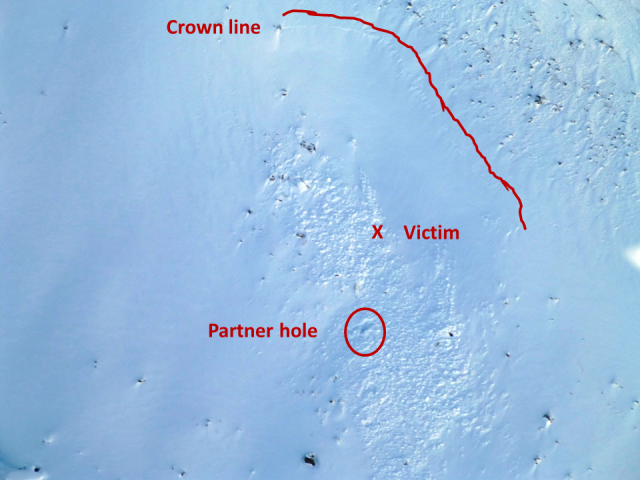
Hayden & Inge were lovers who were living together in Bozeman, MT.
In his grief due to not being able to save his girlfriend, Hayden took his own life on October 8th, 2017.
“Over the last few years, however, as I’ve watched too many friends go to the mountains only to never return, I’ve realized something painful. It’s not just the memorable summits and crux moves that are fleeting. Friends and climbing partners are fleeting, too. This is the painful reality of our sport, and I’m unsure what to make of it. Climbing is either a beautiful gift or a curse.”
– Hayden Kennedy told eveningsends in September, 2017

According to CBS News and the director of the Gallatin National Forest Avalanche Center, Doug Chabot, Hayden did not call 911 when he returned home after the avalanche on October 7th, 2017.
Instead, Hayden left a detailed note outlining exactly where Inge was located.
“It all came out in this incredibly detailed and well-thought-out note. He basically left nothing to chance in finding Inge.” – Doug Chabot told CBS News
Cabot told CBS news that the note included GPS coordinates, details about their route, and told of the probe and shovel Hayden had left in the avalanche debris to mark the accident location (see video below).
Doug Chabot has told SnowBrains that the note Hayden wrote “ended up with the Bozeman Police Department the night he was found (October 8th, 2017).”

Important Facts From the MT Avalanche Report:
- Inge Perkins’ avalanche transceiver was turned off and in her backpack when her body was located by rescuers.
- The two skiers had not done a beacon check.
- Rescuers located Inge with avalanche probes on October 9th, 2017.
- Nine search and rescue volunteers, including 2 avalanche dogs, searched the avalanche debris for the missing skier.
- The two skiers had hiked 6 miles on mostly dirt trails from the Upper Taylor Fork trailhead to the north couloir of Imp Peak in the southern Madison Range on the morning of October 7th, 2017.
- Near the bottom of the couloir (10,000’), they triggered an avalanche while ascending on skis with skins.
- The avalanche was 1-2’ deep at the crown, approximately 150’ wide, and 300’ long.
- The slope where the avalanche released was 38-45° steep with a north-northeast aspect.
- Both skiers were caught, one was partially buried and one was fully buried.
- Hayden searched for his partner, was unable to locate her, and then hiked alone out from the area.
- On October 9th, 2017, Gallatin County Search and Rescue recovered the body of Inge who was 3’ deep.
- The avalanche is classified HS-ASu-R3-D2-O with a runout angle of 27°.
Report: Imp Peak, MT Avalanche Fatality
by MT Avalanche on October 12th, 2017
SYNOPSIS
Imp Peak Avalanche Fatality
2 skiers caught, 1 fully buried and killed and 1 partially buried Southern Madison Range, MT
Custer Gallatin National Forest – October 7, 2017
On Saturday, October 7, two skiers hiked 6 miles from the Upper Taylor Fork trailhead to the north couloir of Imp Peak in the southern Madison Range, approximately 20 miles south of Big Sky. Near the bottom of the couloir (10,000’), they triggered an avalanche while ascending on skis with skins. The avalanche was 1-2’ deep at the crown, approximately 150’ wide, and 300’ long. The slope where the avalanche released was 38-45° steep with a north-northeast aspect (photo, photo). Both skiers were caught, one was partially buried and one was fully buried. Skier 1 searched for his partner, was unable to locate her, and then hiked alone out from the area. On Monday, October 9, Gallatin County Search and Rescue recovered the body of Skier 2 who was 3’ deep. Personnel located her with avalanche probes. The avalanche is classified HS-ASu-R3-D2-O with a runout angle of 27°.
GPS coordinates and elevation:
Starting zone: 44°59’46.09”N, 111°27’20.45”W (10,008’)
Victim burial location: 44°59’47.17”N, 111°27’20.56”W (9,990’)
Toe of debris: 44°59’49.07”N, 111°27’19.27”W (9,886’)

WEATHER
Snow depth and precipitation data were collected from the Carrot Basin SNOTEL site located at 9,000’, approximately 10 miles east of the avalanche site. Wind speed and direction data were gathered from the Yellow Mule weather station at 9,200’, approximately 13 miles north-northeast of the avalanche site.
Prior to the avalanche on October 7, Carrot Basin SNOTEL had received 12” of snow from October 1 to 5. On October 6 wind at the Yellow Mule weather station was south-southwest at 15-25 mph with gusts to 38 mph, increasing on the morning of October 7 to 25-35 mph with gusts to 62 mph. Temperatures during the week prior were high 20s F to low 40s F, and reached 44° F at Yellow Mule and 47° F at Carrot Basin in the afternoon the day of the avalanche.

SNOWPACK
The avalanche occurred at 10,000’ on Imp Peak in the southern Madison Range. The crown was approximately 150 feet wide (measured on Google Earth) and 1-2 feet deep (estimated by size of debris chunks because crown and path were reloaded). The slope of the starting zone ranged from 38-45° (measured with inclinometer) with a north to northeast aspect (30°-60°). The slide ran 300 linear feet and 175 vertical feet with a runout angle of 27°. The avalanche is classified HS-ASu-R3-D2-O.
The first snowfall of the 2017-18 winter came before the official end of summer, on September 15, 2017. From September 15 to 30 the Carrot Basin SNOTEL received 3.5” of water equivalent precipitation, which totaled 3-4’ of snow. The snowpack at all SNOTEL sites in our advisory contained the highest amount of snow water equivalent on record for each day from September 20-26. From October 1 to 5 the Carrot Basin SNOTEL received one foot of snow equal to .8” SWE, on top of the old snow from September.
The avalanche was a hard slab of wind-drifted snow that collapsed on a layer of soft snow underneath, and slid on the old snow from late September. Strong south-southwest wind on October 6 and 7 drifted recent new snow into a very hard slab (P+). This slab rested above a layer of soft (F+), small grained (.3-.5mm) mix of decomposing new snow and faceted crystals. Below this soft layer was a hard (1F), 2.5’ thick layer of old snow on the ground from September, which formed a bed surface for the hard slab to slide (snowpit profile).
The most recent avalanche and weather information bulletin was issued on October 3. Heavy early season snow prompted the avalanche center to issue intermittent bulletins to provide basic info for safe travel, and to remind people to travel and prepare for avalanches as though it is the middle of winter.
Pre-season avalanche bulletin: http://www.mtavalanche.com/advisory/17/10/03
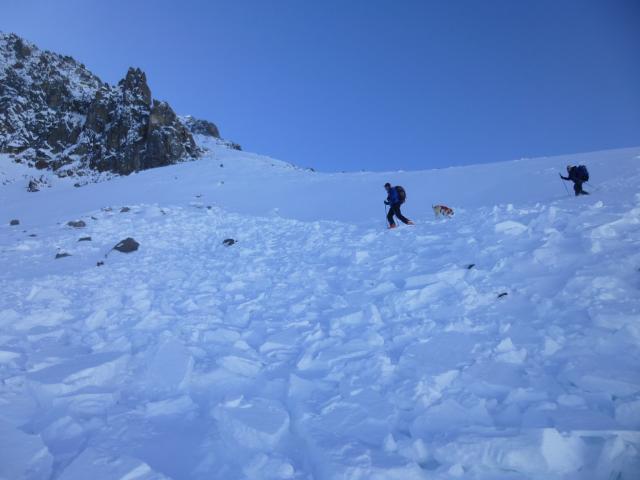
AVALANCHE
The specific events leading to the avalanche, and exact preparation and motives of the two skiers are not entirely known. The GNFAC received details regarding the event from the Gallatin County Sheriff’s Office.
On Saturday, October 7, a pair of skiers, Skier 1 (male, 27) and Skier 2 (female, 23), hiked from the Upper Taylor Fork trailhead to Imp Peak (11,202’) in the southern Madison Range of southwest Montana. They were experienced skiers and had both taken a Level 2 avalanche class. They intended to ski the north couloir on Imp Peak, a known ski route described by author Thomas Turiano in Select Peaks of Greater Yellowstone: A Mountaineering Guide and History:
“The mountain’s most distinctive features are a pair of steep and wide couloirs that drop from the broad saddle between the summits over 1,000 feet down both the north and south sides of the mountain… These weaknesses provide the easiest routes to the summit when filled with snow in winter or spring. They each are about 40 degrees steep near the top and ease to about 30 degrees at the bottom.”
The pair left the trailhead (7,250’) at 0600 on Saturday for a 6 mile approach to the peak. Hiking on a dirt trail, carrying their equipment, they likely transitioned to ski gear at snowline around 9,200’. Near 10,000’ at the bottom of the couloir, they were ascending on skis with skins when they triggered the avalanche. Both were caught, Skier 1 was buried to his mid-chest and back of neck, and Skier 2 was fully buried. Skier 1 had an avalanche beacon, shovel and probe. Skier 2 had a shovel, probe, and an avalanche beacon that was turned off in her backpack. We have no knowledge about Skier 1’s beacon prior to the search.
Skier 1 dug himself out of the debris. He turned his beacon to “search” and scanned the debris for Skier 2, but did not get a signal. They had not done a previous beacon check. He attempted to locate her by probing and shoveling through the debris. After three hours of searching, Skier 1 was unable to find Skier 2 and walked out alone.
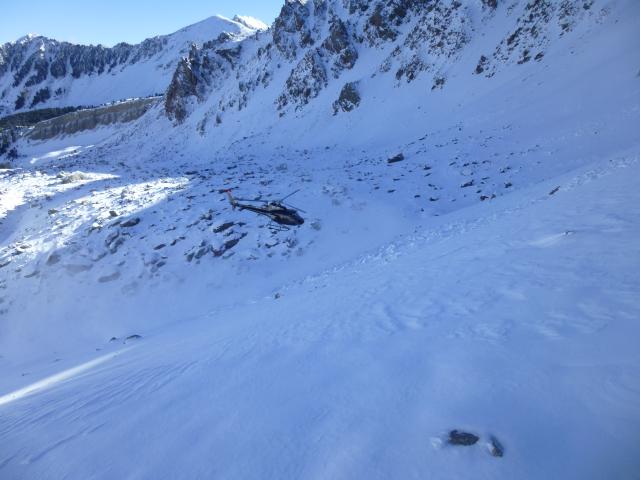
RESCUE
Times are from the log at GCSAR Dispatch and rescuers’ notes.
On Sunday evening, October 8 around 2200 hours, Gallatin County Search and Rescue (GCSAR) was notified of the avalanche and location of Skier 2. They were told the debris was marked with Skier 1’s probe. On the morning of October 9, Rescuers from GCSAR, Big Sky Search and Rescue (BSSAR), and forecasters Alex Marienthal and Doug Chabot from the Gallatin National Forest Avalanche Center (GNFAC) flew by helicopter to locate the avalanche and find Skier 2. Team 1 of rescuers consisted of Chabot plus two GCSAR members and one search dog. They were picked up from GCSAR Valley Base around 0915 and flown to the coordinates given for Imp Peak. At 1020 they were dropped off at the site after sighting the avalanche debris and Skier 1’s probe. Incident Command (IC) set up at the Taylor Fork road at Wapiti Creek Trailhead. Marienthal and members from BSSAR and GCSAR staged there to meet the helicopter. Team 2 consisted of Marienthal, two rescuers and a second search dog. They were flown to the avalanche site at 1100. Three more rescuers (team 3) were dropped off at the avalanche site at 1110.
Rescuers did a beacon search, Recco search, spot probed likely burial areas, and search dogs worked the debris. At 1122, Chabot confirmed a solid probe strike and Skier 2 was excavated and packaged for transport. Skier 2 was long lined by helicopter to I.C. at 1144 and transported to Big Sky hospital. The helicopter transported team 3 and team 2 back to I.C. at 1228, and team 1 was picked up and returned to GCSAR Valley Base at 1302.
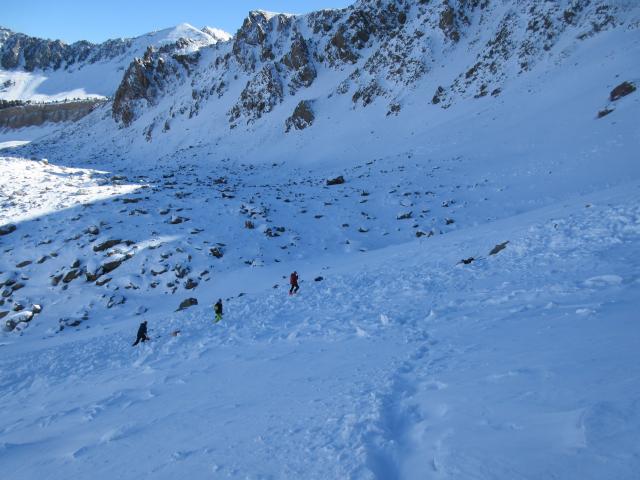
INVESTIGATION
The onsite avalanche investigation occurred on October 9, 2017. It was conducted by Doug Chabot and Alex Marienthal of the Gallatin National Forest Avalanche Center.
Please contact either Doug or Alex if you have questions.
Doug Chabot
Director
Gallatin National Forest Avalanche Center 406-587-6984
dchabot@fs.fed.us
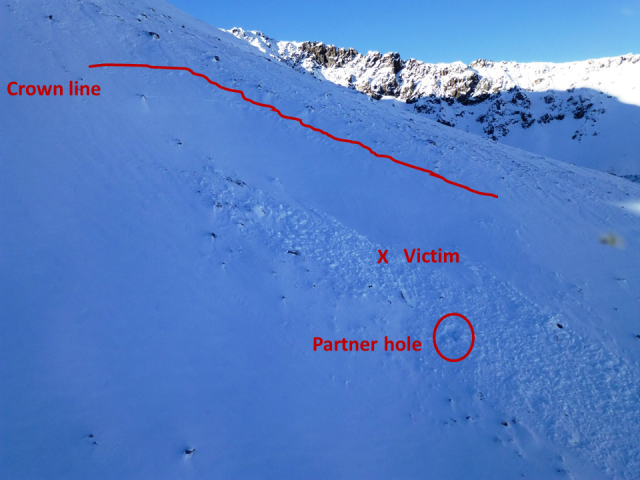
Alex Marienthal
Avalanche Specialist
Gallatin National Forest avalanche Center 406-587-6984
amarienthal@fs.fed.us
An incredible thought provoking article thank you for all the information so many lessons to be learned. My thoughts are with the families David Whalley Scotland